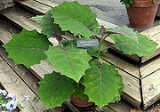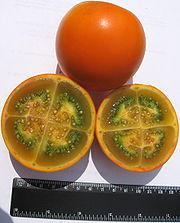
Naranjilla
Encyclopedia

Orange (fruit)
An orange—specifically, the sweet orange—is the citrus Citrus × sinensis and its fruit. It is the most commonly grown tree fruit in the world....
") in Ecuador
Ecuador
Ecuador , officially the Republic of Ecuador is a representative democratic republic in South America, bordered by Colombia on the north, Peru on the east and south, and by the Pacific Ocean to the west. It is one of only two countries in South America, along with Chile, that do not have a border...
and as lulo ([ˈlulo], from Quechua
Quechua languages
Quechua is a Native South American language family and dialect cluster spoken primarily in the Andes of South America, derived from an original common ancestor language, Proto-Quechua. It is the most widely spoken language family of the indigenous peoples of the Americas, with a total of probably...
) in Colombia
Colombia
Colombia, officially the Republic of Colombia , is a unitary constitutional republic comprising thirty-two departments. The country is located in northwestern South America, bordered to the east by Venezuela and Brazil; to the south by Ecuador and Peru; to the north by the Caribbean Sea; to the...
, is a subtropical perennial plant
Perennial plant
A perennial plant or simply perennial is a plant that lives for more than two years. The term is often used to differentiate a plant from shorter lived annuals and biennials. The term is sometimes misused by commercial gardeners or horticulturalists to describe only herbaceous perennials...
from northwestern South America
South America
South America is a continent situated in the Western Hemisphere, mostly in the Southern Hemisphere, with a relatively small portion in the Northern Hemisphere. The continent is also considered a subcontinent of the Americas. It is bordered on the west by the Pacific Ocean and on the north and east...
. The specific name for this species of nightshade
Solanum
Solanum, the nightshades, horsenettles and relatives, is a large and diverse genus of annual and perennial plants. They grow as forbs, vines, subshrubs, shrubs, and small trees, and often have attractive fruit and flowers. Many formerly independent genera like Lycopersicon or Cyphomandra are...
means "from Quito
Quito
San Francisco de Quito, most often called Quito , is the capital city of Ecuador in northwestern South America. It is located in north-central Ecuador in the Guayllabamba river basin, on the eastern slopes of Pichincha, an active stratovolcano in the Andes mountains...
."
The naranjilla plant is attractive, with large heart-shaped leaves up to 45 cm in length. The leaves and stems of the plant are covered in short purple hairs. Naranjilla are delicate plants and must be protected from strong winds and direct sunlight. They grow best in partial shade.
The fruit has a citrus flavour, sometimes described as a combination of rhubarb
Rhubarb
Rhubarb is a group of plants that belong to the genus Rheum in the family Polygonaceae. They are herbaceous perennial plants growing from short, thick rhizomes. They have large leaves that are somewhat triangular-shaped with long fleshy petioles...
and lime
Lime (fruit)
Lime is a term referring to a number of different citrus fruits, both species and hybrids, which are typically round, green to yellow in color, 3–6 cm in diameter, and containing sour and acidic pulp. Limes are a good source of vitamin C. Limes are often used to accent the flavors of foods and...
. The juice
Juice
Juice is the liquid that is naturally contained in fruit or vegetable tissue.Juice is prepared by mechanically squeezing or macerating fruit or vegetable flesh without the application of heat or solvents. For example, orange juice is the liquid extract of the fruit of the orange tree...
of the naranjilla is green
Green
Green is a color, the perception of which is evoked by light having a spectrum dominated by energy with a wavelength of roughly 520–570 nanometres. In the subtractive color system, it is not a primary color, but is created out of a mixture of yellow and blue, or yellow and cyan; it is considered...
and is often used as a drink
Drink
A drink, or beverage, is a liquid which is specifically prepared for human consumption. In addition to fulfilling a basic human need, beverages form part of the culture of human society.-Water:...
.
Classification
Within the genus SolanumSolanum
Solanum, the nightshades, horsenettles and relatives, is a large and diverse genus of annual and perennial plants. They grow as forbs, vines, subshrubs, shrubs, and small trees, and often have attractive fruit and flowers. Many formerly independent genera like Lycopersicon or Cyphomandra are...
, S. quitoense is a part of the leptostemonum clade
Clade
A clade is a group consisting of a species and all its descendants. In the terms of biological systematics, a clade is a single "branch" on the "tree of life". The idea that such a "natural group" of organisms should be grouped together and given a taxonomic name is central to biological...
. Within this clade, S. quitoense belongs to the Lasiocarpa clade. Other species within this clade include: S. candidum, S. hyporhodium, S. lasiocarpum, S. felinum, S. psudolulo, S. repandum and S. vestissimum.
Other plants bear morphological similarity to S. quitoense, but they may or may not be closely related. Some of these plants are: S. hirtum, S. myiacanthum, S. pectinatum, S. sessiliflorum and, S. verrogeneum. Many of these plants, related or not, can be confused with S. quitoense. Furthermore, Solanum quitoenses physical traits vary from plant to plant, making identification challenging: at least three varietals (with spines, without spines, or a third variety known as baquicha, which features red-ripening fruits and smooth leaves) are known to occur. One characteristic that is unique to S. quitoense is the ring of green flesh within the ripe fruit.The only related fruit to have green flesh is the cultivated variant of Solanum lasiocarpum
Solanum lasiocarpum
Solanum lasiocarpum, otherwise known as Indian nightshade, is a plant that produces edible fruit. Its flowers are white and its fruits are pale yellow. S. lasiocarpum is native to temperate Asia, tropical Asia and the pacific....
.
The new growth of this plant is densely covered in protective trichome
Trichome
Trichomes are fine outgrowths or appendages on plants and certain protists. These are of diverse structure and function. Examples are hairs, glandular hairs, scales, and papillae.- Algal trichomes :...
s. Coloration in the plant's trichomes around the new growth and flowers varies from purple to white. Identification can be difficult for this reason.
Synonyms
This plant has been described under a number of synonymSynonym (taxonomy)
In scientific nomenclature, a synonym is a scientific name that is or was used for a taxon of organisms that also goes by a different scientific name. For example, Linnaeus was the first to give a scientific name to the Norway spruce, which he called Pinus abies...
s:
- Solanum angulatum Ruiz & Pav.
- Solanum macrocarpon Molina (non L.: preoccupied)
- Solanum macrocarpon Pav. ex Dunal in DC. (nomen nudumNomen nudumThe phrase nomen nudum is a Latin term, meaning "naked name", used in taxonomy...
, preoccupied) - Solanum nollanum Britton
- Solanum quitense Kunth
- Solanum quitoense f. septentrionale (R.E.Schult. & Cuatrec.) D'Arcy
- Solanum quitoense var. septentrionale R.E.Schult. & Cuatrec.
Agriculture
The naranjilla has been proposed as a new flavouring for the global food industry, but it fares poorly in large-scale cultivation, presenting an obstacle to its wider use. Its fruit, like tomatoes, is easily damaged when ripe, so is usually harvested unripe. The fruits are found at markets. It is common for locals to make beverages by adding sugar and water to the freshly squeezed fruits. Locals will also add salt to the fresh fruit, cut it into pieces, and eat it.Pests & diseases
Pests easily destroy a crop of this species. This limits its use for agriculture. One common type of infectionInfection
An infection is the colonization of a host organism by parasite species. Infecting parasites seek to use the host's resources to reproduce, often resulting in disease...
is caused by the root-knot nematode
Nematode
The nematodes or roundworms are the most diverse phylum of pseudocoelomates, and one of the most diverse of all animals. Nematode species are very difficult to distinguish; over 28,000 have been described, of which over 16,000 are parasitic. It has been estimated that the total number of nematode...
. The ripe fruit can be attacked by fungus fairly easily, so it is often picked unripe to avoid rotting.
Hybrids are an increasingly popular solution to the nematode pest problem. Solanum quitoense has been hybridized with other plants, most commonly with S. sessiliflorum
Solanum sessiliflorum
Solanum sessiliflorum or Cocona is a tropical shrub belonging to the Solanaceae family. The cocona plant has sturdy branches and huge, serrate and hairy leaves. Cocona closely resembles a number of close relatives, including naranjilla and pseudolulo. It can be distinguished from those plants by...
, a plant with similar phenotypic traits. The leaves, flowers and fruits of S. sessiliflorum are similar in form to S. quitoense, but has much larger fruits that are yellow; the resulting hybrids have fruits with yellowish fruit pulp.
Nutrition
Contents of the fruit varies from region to region. These statistics are based on Costa Rican fruit:| fruit nutrients | percent contained in fruit |
|---|---|
| Water | 90% |
| Protein | 1% |
| Fat | less than .0001% |
| Carbohydrates | 3.8% |
| Fiber | 1.4% |
| Sugar | 3% |
| Calories | (kcal/100g) 18 |
| Vitamin C | 2.6% |
These statistics are based on fruits found in Colombia
Colombia
Colombia, officially the Republic of Colombia , is a unitary constitutional republic comprising thirty-two departments. The country is located in northwestern South America, bordered to the east by Venezuela and Brazil; to the south by Ecuador and Peru; to the north by the Caribbean Sea; to the...
and Ecuador
Ecuador
Ecuador , officially the Republic of Ecuador is a representative democratic republic in South America, bordered by Colombia on the north, Peru on the east and south, and by the Pacific Ocean to the west. It is one of only two countries in South America, along with Chile, that do not have a border...
:
| Fruit nutrients | mg per 100g of nutrients. |
|---|---|
| Calcium | 5.9-12.4 mg |
| Phosphorus | 12.0-43.7 mg |
| Iron | 0.34-0.64 mg |
| Carotene | 0.071-0.0232 mg |
| Thiamine | 0.04-0.094 |
| Riboflavin | 0.03-0.047 |
| Niacin | 1.19-1.76 |
External links
- PLANTS National Database Reports and Topics SOQU
- GRIN/NPGS Taxonomy information Solanum quitoense Lam.Jean-Baptiste LamarckJean-Baptiste Pierre Antoine de Monet, Chevalier de la Marck , often known simply as Lamarck, was a French naturalist...
- Naranjilla in Fruits of Warm Climates by Morton, Julia F.Julia MortonJulia Francis McHugh Morton was an American author and botanist. She was research professor of biology, and director of the Morton Collectanea at the University of Miami. She was elected a Fellow of the Linnean Society of London in 1974...
1987

